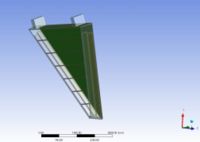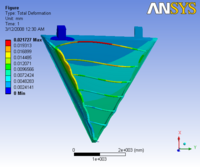Difference between revisions of "Progress reports"
| Line 18: | Line 18: | ||
| − | A max deflection of 22 microns is predicted from our current ANSYS model. Only the left hinge is constrained. | + | A max deflection of 22 microns is predicted from our current ANSYS model. Only the left hinge is constrained. No gravity and no differential gas pressure. Effective Youngs modulus is used. The carbon fiber rods and the hexcell backing sheet are the only materials not made from the poly foam composite. Poly foam used on endplates, back plate, and nose plate. No Al frame around endplate. |
[[Image:R3_3D_AnsysModel_Deflection_3-12-08.png | 200 px]] | [[Image:R3_3D_AnsysModel_Deflection_3-12-08.png | 200 px]] | ||
[[Media:Deflection_3-12-08.pdf]] | [[Media:Deflection_3-12-08.pdf]] | ||
Revision as of 19:51, 14 March 2008
R3 design Progress report
3/11/08
Progress modeling the R3 drift chamber has been held back by both software and hardware problems. This past week we installed ANSYS on a faster computer ( 2 GHz Intel with 3Meg RAM) and were able to render the design in 30 minutes instead of 2 hours. The turnaround for debugging the geometrical design is now faster and ANSY does not currently crash. We plan on doing the same test using a new computer (2 GHz Intel with 8 Meg RAM) once it has been assembled (2 weeks or less).
The image below represent the current Model which has been implemented in ANSYS.
3/18/08
1.) Movies showing deflections as a function of applying the max load and then releasing it. The two movies below show the two endplate deflections with no rods for either 1 fixed or 2 fixed mount points.
A max deflection of 22 microns is predicted from our current ANSYS model. Only the left hinge is constrained. No gravity and no differential gas pressure. Effective Youngs modulus is used. The carbon fiber rods and the hexcell backing sheet are the only materials not made from the poly foam composite. Poly foam used on endplates, back plate, and nose plate. No Al frame around endplate.

